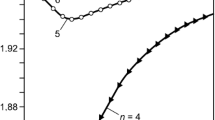Abstract
I provide evidence for the importance of the Jeffreys law of error in the analysis of O-C residuals. This law is used to show that, under uniform metrological conditions, an experiment is considered to be performed correctly only if the O-C values have a t-distribution with five to nine degrees of freedom (ν) or Jeffreys’s form of the Pearson type VII distribution with the exponent m of three to five. Under nonuniform conditions, the left boundary for ν can move to the left but cannot be less than three, and the left boundary for m can also move to the left but cannot be less than two.
Similar content being viewed by others
References
N. A. Borodachev, Basic Aspects of Production-Accuracy Theory, Ed. by A. N. Kolmogorov (Akad. Nauk SSSR, Moscow, 1950) [in Russian].
K. F. Gauss, Selected Geodesic Works, Vol. 1: The Least Squares Method (Izd-vo geodez. lit, Moscow, 1957), Vol. 1 [in Russian].
I. V. Dzhun’, “Pearson VII Type Distribution in Errors of Latitude Oscillation Observations,” Astrom. Astrofiz., No. 2, 101–115 (1969).
I. V. Dzhun’, “On the Appointment of Scales to Astronomical Observations,” Astrom. Astrofiz., No. 10, 26–34 (1970).
I. V. Dzhun’, “Fluctuations in Weight of Individual Measurements of the Gravity Acceleration and the Way of their Account for the Ballistic Observations,” in Repeat Gravimetrical Observations (MGK pri Prezid. AN SSSR, Neftegeofizika, Moscow, 1983), pp. 43–52 [in Russian].
I. V. Dzhun’, “Some Aspects of Practical Using of L p and Excess-Estimations in Processing of Geodesical Measurements,” Izv. Vyssh. Uchebn. Zaved., Geodez. Aerofotos’emka, No. 4, 43–48 (1986).
I. V. Dzhun’, “On Boundaries of Rao-Cramer Inequality for Dispersion of Estimates of Pearson VII Type Distribution Parameters,” Kinem. Fiz. Nebes. Tel 4, 85–87 (1998).
I. V. Dzhun’, “Pearson VII Type Distribution of Errors of HIS Laser Observations,” Kinem. Fiz. Nebes. Tel 7(3), 82–91 (1991).
I. V. Dzhun’, “Mathematical Processing of Astronomical and Cosmic Information with Nongaussian Observation Errors,” Extended Abstract of Doctoral Dissertation in Mathematics and Physics (GAO AN Ukrainy, Kiev, 1992).
I. V. Dzhun’, “Does the Method of Least Squares Outdate?,” Kinem. Fiz. Nebes. Tel 16(3), 281–288 (2000).
I. V. Dzhun’, G. P. Arnautov, Yu. F. Stus’, and S. N. Shcheglov, “Features of Law of Ballistic Measurement Distribution of Gravity Acceleration,” in Repeat Gravimetrical Observations (MGK pri Prezid. AN SSSR, Neftegeofizika, Moscow, 1984) [in Russian].
I. V. Dzhun’ and V. I. Somov, “On Some Fundamental Questions of Mathematical Processing of Geophysical Information,” in Geodynamical Studies in Ukraine (Kiev, 1996), pp. 167–178 [in Russian].
G. A. Ivanov, T. P. Sergeeva, and A. I. Yatsenko, “The Choice of Measurement Mode in FON Program on Automatic Machine PARSEK,” Kinem. Fiz. Nebes. Tel 6(1), 79–83 (1990).
I. G. Kolchinskii, Observation and Fact in Astronomy (Naukova Dumka, Kiev, 1982) [in Russian].
A. K. Korol’, Declinations of Bright and Weak Stars in Unified System (Naukova Dumka, Kiev, 1969) [in Russian].
A. Migdal, “Is the Space Symmetric?,” Nauka Zhizn’, No. 9, 53–57 (1971).
K. F. Ogorodnikov, “Observation Processing Method with Mean Weight Imposition with Application to Statistical Study of Stellar Motions,” Astron. Zh. 5(1), 1–21 (1928).
A. I. Orlov, “How Often is the Distribution of Observation Results Normal?,” Zavod. Lab., No. 7, 64–66 (1991).
A. I. Orlov, “High Statistical Technologies,” Zavod. Lab. 69(11), 55–60 (2003).
F. R. Hampel, E. M. Ronchetti, P. J. Rousseeuw, and W. A. Stahel, Robust Statistics: The Approach Based on Influence Functions (Wiley, New York, 1986; Mir, Moscow, 1989).
A. S. Kharin and Ya. S. Yatskiv, “Study of Observation Errors of Goloseev Catalogue of Latitude Program Stars,” Astrom. Astrofiz., No. 10, 34–43 (1970).
P. Huber, Robust Statistics, Wiley Series in Probability and Statistics (Wiley Intersci., New York, 1981; Mir, Moscow, 1984).
Ya. S. Yatskiv and A. A. Molotai, “Using of Optimal Linear Estimates of Mathematical Expectation and Standard Deviation during Processing of Astronomical Observation Results,” Astrom. Astrofiz., No. 37, 56–60 (1979).
R. L. Branham, “Techniques for Dealing with Discordant Observations,” in Relativity in Celestial Mechanics and Astronometry (Reidel, Dordrecht, 1986), pp. 229–230.
D. G. Broslavets, I. V. Dzhun’, G. K. Gorel, and L. A. Gudkova, “Research on Statistical Distributions of Observation Errors of Minor Panets,” in Extension and Connection of Reference Frames using Ground Bases CCD Technique, Proceedings of the International Astronomical Conference (Atoll, Nikolaev, 2001), pp. 150–156.
I. V. Dzhun’ and P. V. Novitskij, “Comments upon the Use of the Pearson Law of Type VII in Astronometry,” Kinem. Phys. Celest. Bodies 8(5), 78–81 (1992).
V. Gazda, Normal Probability Distribution in Financial Theory-False Assumption and Consequences (Department of Economics, Univ. of Economics, Faculty of Business Ekonomics, Kosice, 1999), pp. 3–6.
V. Gazda and I. V. Dzhun’, “About Distribution of Stock Index Returns Fluctuations,” Business Rev.: Sci. J. Faculty of Business Economics Univ. Economics Bratislava 1(2), 20–27 (2002).
H. Jeffreys, “The Law of Error and the Combination of Observations,” Phil. Trans. R. Soc. London A 237, 231–271 (1937).
H. Jeffereys, “The Law of Error in the Greenwich Variation of Latitude Observations,” Mon. Not. R. Astron. Soc. 99(9), 703–709 (1939).
H. Jeffreys, Theory of Probability, 2nd ed. (Oxford, 1940).
K. Pearson, “On the Mathematical Theory of Errors of Judgment, with Special Reference to the Personal Equation,” Phil. Trans. R. Soc. London A 198, 253–296 (1902).
E. E. Peters, “Fractal Market Analysis,” in Applying Chaos Theory to Investment and Economics (Wiley, New York, Chichester, Brisbane, Toronto, Singapore, 1981), pp. 18–53.
J. W. Turkey, “The Future of Data Analysis,” Ann. Math. Stat. 33, 1–67 (1967).
Author information
Authors and Affiliations
Additional information
Original Russian Text © I.V. Dzhun’, 2012, published in Kinematika i Fizika Nebesnykh Tel, 2012, Vol. 28, No. 1, pp. 72–80.
About this article
Cite this article
Dzhun’, I.V. What should be the observation-calculation residuals in modern astrometric experiments?. Kinemat. Phys. Celest. Bodies 28, 43–47 (2012). https://doi.org/10.3103/S0884591312010096
Received:
Published:
Issue Date:
DOI: https://doi.org/10.3103/S0884591312010096




